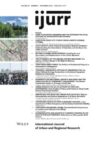Recent research questions the relevance of urban industrial zoning in the context of industry change and competitive property markets, but overlooks the place-based variation and complexities that define contemporary industrial districts. Drawing on comparative case study research in Melbourne, Australia, this article explores the changing character of industrial zones and the relationship between zoning, industrial gentrification and agglomeration. We highlight how zoning context and regulations enable both classic processes of agglomeration and industrial gentrification. Industrial activity persists and may simultaneously benefit from and compete with knowledge and creative industries and specialized manufacturers that serve gentrifying local markets. Our findings provide important insights into the different conditions and challenges involved in contemporary industrial zoning, and emphasize the need for industrial land use policy that better responds to contemporary conditions.
Details
Written by:
Carl Grodach, Elizabeth Taylor, Joe Hurley, Declan Martin
Digital Object Identifier (DOI)
https://doi.org/10.1111/1468-2427.70013
About DOI
